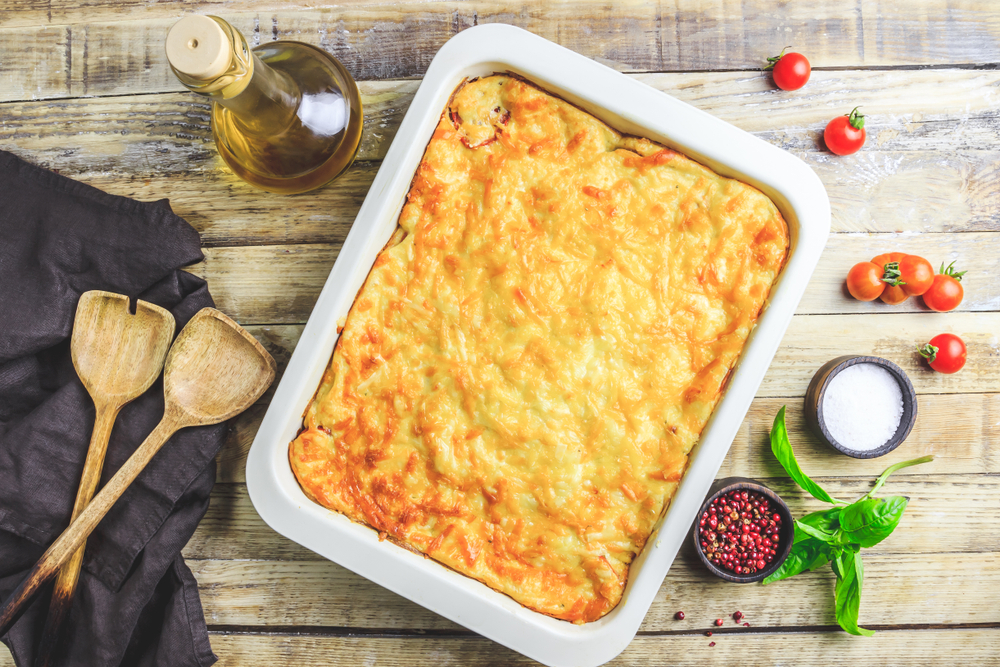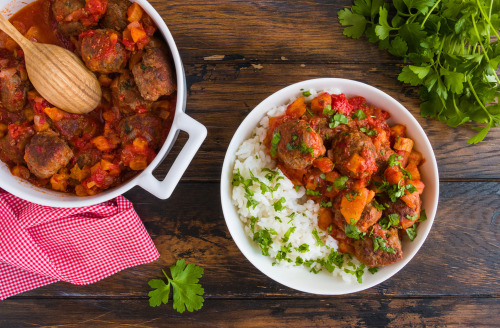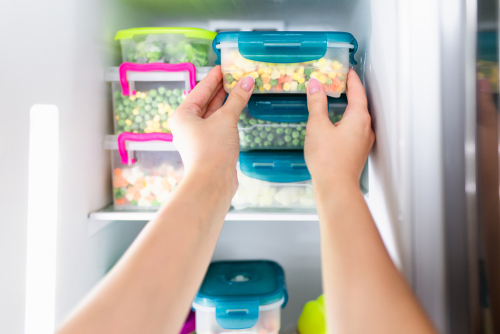Casseroles are nutrient-rich meals that are usually very easy to prepare using whatever you have on hand.
Since the food is baked, you can also prepare them in everything from conventional ovens to solar cookers and campfires. That being said, in order to get the most out of casseroles in survival situations, it helps to know more about proper cookware and a few simple preparation tips.
Choosing a Casserole Dish
When you don’t have to worry about traveling with a casserole dish, or using it in a wide range of settings, you may think that any casserole dish will work for survival purposes. Unfortunately, if you take this perspective, you will lose out on one of the most important aspects of preparing casseroles quickly and easily under any circumstance. Here are some casserole dish types to choose from. You may find that one or more will be needed to cover all possible cooking, serving, and storage elements.
- Corningware – These are usually the cheapest casserole dishes on the market. You can use them in the oven, microwave, freezer, and dishwasher. To keep Corningware in good condition, you cannot use metal utensils. You will also find they can be very hard to clean up after use.
- Glass (such as Pyrex, Anchor Hocking, etc) – These casserole dishes are made out of clear glass. They are also very cheap but are inclined to break if you drop them. Depending on the manufacturer, glass casserole dishes may or may not be safe for the freezer, oven, and dishwater. Most cannot be used on a stovetop, under a broiler, or in temperatures over 425 – 450 degrees. In addition, glassware cannot tolerate sudden temperature changes. If you want to refrigerate after baking, the glassware and food will have to stay at room temperature until it is cool enough to go in the refrigerator.
- Stoneware – Most stoneware casserole dishes are similar to glass in the sense that they do not tolerate rapid temperature changes well. That being said, they are a bit sturdier and can be used around 7 inches away from a broiler element. They are more expensive than glass and corning ware casserole dishes.
- Stainless Steel Dishes – If you are looking for a durable casserole dish, stainless steel versions will meet most of your needs. They can be used on stovetops and ovens. You can broil in them, and also place them in the refrigerator with no problems. Stainless steel will not shatter if it is exposed to extreme temperatures. If you drop one of these casserole dishes, it may get a ding or two, but can still be used. The only problem with this and other metal casserole dishes is it cannot be used in a microwave. That being said, if you are in an emergency situation where electricity is not available, you may be more interested in a casserole dish that can withstand a campfire or other alternative cooking form.
- Emile Henry Flame Ceramic – This casserole dish can be used in just about any cooking situation. It will tolerate extreme temperature changes and is also safe to use in the oven, on the stovetop, under the broiler, and in the microwave. These casserole dishes can also be easily placed in a refrigerator. While these are more expensive dishes, they are well worth it.
The Five Main Parts Of A Casserole
Even if you already have dozens of favorite casserole recipes, there is a chance that you will not have all the ingredients in a time of need. Fortunately, casseroles are very flexible and can be made out of just about anything that is available. When figuring out what to add to an ad hoc casserole, it helps to know the five basic parts:
- Proteins – The most protein found in casseroles comes from meat, fish, or cheese. You can use conventional meats such as beef, chicken, turkey, and pork, or meat from animals that you hunt such as deer or rabbit. Vegan and vegetarian casseroles may also use beans or other high protein foods for this part of the dish. The protein part of a casserole should be chopped or shredded into small pieces if it isn’t already in a sufficiently small size.
- Thickeners – This element is what makes casseroles feel so hearty, and provides the carbohydrates. You can use potatoes, pasta, rice, flour, or anything else that will blend well with the meats you have chosen. If higher carbohydrate foods are not available, then you can try wild roots and other vegetables that may be on hand. As with proteins, thickeners should also be cut into cubes or shredded so that they mix easily with other ingredients.
- Binders – This is the semi-liquid part of the casseroles that keeps all the other parts together. Gravies, thick sauces, cream soup, and even eggs can be used as a binder. If the primary protein is meat, some people also consider a melt-able, soft cheese as a binder.
- Flavoring agents – As the casserole cooks, the meats and other ingredients will release liquids that combine to help develop the binder. Some people also add spices as well as beer or wine. Remember, the alcohol evaporates very quickly upon heating. Therefore, the casserole will still retain a certain flavor to it without getting you drunk.
- Toppings – Aside from flavorings, this can easily be the most memorable part of a casserole. You can use just about anything that will complement the other foods used in the dish. For example, if you are making a fruit casserole, a marshmallow topping might be appropriate. On the other hand, if you are making a macaroni casserole, you might be better off with some kind of cheese.
Should You Pre-cook Casserole Ingredients?
If you enjoy cooking meat, then you probably brown or sear it before using it in casseroles or roasting. Technically, it is not necessary to brown meat before putting it in a casserole. Nevertheless, if you want a tasty casserole that brings out the best flavor in the meat, browning it is the fastest and most efficient method to use.
Some people will tell you there is no need to pre-cook rice and other plant-based ingredients. Raw potatoes, macaroni (with the exception of homemade fresh, non-dried out pasta), and rice can all take hours to cook in a casserole dish. You can save time by boiling these foods first so that they are about 2/3 done before using them in a casserole.
Cooking Temperature and Duration
If you are working with an actual recipe, just follow the temperature instructions given. The actual time it takes will depend on a number of things including geographic elevation, pre-cooking, and how long you choose to leave the casserole in the oven after it is technically safe to eat (ie. reaches a temperature that kills off all pathogens).
In a situation where you are making up your own casserole, start off with a temperature of 350 degrees. If you are using wild meats, use a higher temperature if you would do so for other preparations, or pre-cook the meat before putting it in the casserole. As with a conventional recipe, you may need to adjust the cooking time to accommodate higher altitudes and personal preference.
Storing Casseroles in the Freezer
Cooking for survival purposes can be different from regular cooking in many aspects. To begin with, you may be more interested in conserving as much fuel as possible. Under these circumstances, you may prepare larger amounts of food so that you get as much out of the fuel on hand.
Aside from that, casseroles are usually made in sufficient quantity to cover 2 or more meals stretched across a week or more. When storing away this amount of food, it makes the most sense to freeze the leftovers (if you do not have electricity, try using ice and salt mixed together in a cooler). Here are some things to consider when freezing casseroles:
- Always cook casseroles fully before freezing them. This is especially important for casseroles that contain meat or cheese because these ingredients can decay at different rates from vegetable ingredients.
- After you dish out the first serving of casserole, put a little extra water in and stir so that it mixes well while cooling. This will help reduce drying out when you warm the food at a later time.
- Before packaging the casserole for freezing, make sure it is cooled completely. Try to break the casserole down into packages that contain enough for a single meal. For example, if you made enough for 3 meals, use one package per meal. This will reduce problems associated with the last servings of casserole drying out and losing flavor from all the thawing, heating, and then refreezing.
- There are several ways to pack casserole for freezing. You can use disposable aluminum foil containers, or make leak-proof pockets out of aluminum foil sheets. Next, wrap the packet in plastic wrap, and then cover that with aluminum foil. The extra wrapping will reduce the risk of freezer burn. Do not forget to eliminate as much air as possible in the wrapping closest to the casserole.
Casseroles are easy to prepare and store for survival use. Choosing the right cooking dish is very important because it ensures you can use the cooking vessel in a wide range of cooking environments. Knowing how to freeze casseroles can also make it easier to conserve on fuel in a time of need.










































































I have done this to baked spaghetti and lasagna. Delishous!